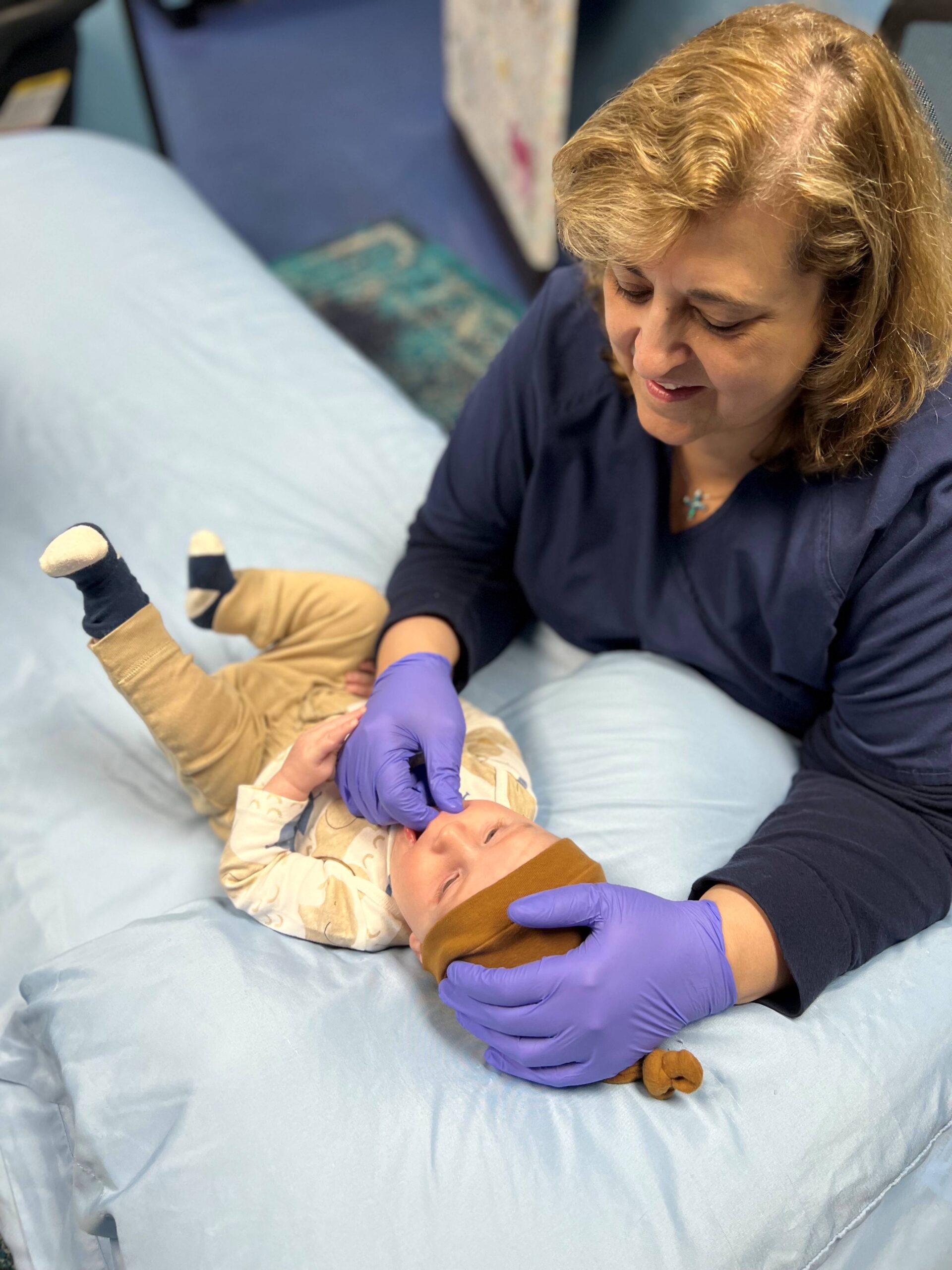
Types of Oral-Motor Issues in Infants
Oral-motor issues in infants can range from mild difficulties to more severe impairments. Some common types include:
Weak Sucking Reflex:
Description: Infants rely on a strong sucking reflex to effectively feed, whether breastfeeding or bottle feeding. A weak sucking reflex can result in inefficient feeding, where the infant struggles to extract enough milk, leading to poor weight gain and nutritional issues.
Signs: Difficulty latching, prolonged feeding times, or inadequate milk intake may be signs of a weak sucking reflex.
Tongue Tie (Ankyloglossia):
Description: This condition occurs when the tissue connecting the tongue to the floor of the mouth is too tight or short, restricting the tongue’s movement. It can interfere with breastfeeding and bottle feeding, as the infant may have difficulty latching properly and maintaining a good seal.
Signs: Limited tongue movement, pain during breastfeeding for the mother, and difficulty with sucking are common indicators of tongue tie.
Lip Tie:
Description: Similar to tongue tie, lip tie occurs when the tissue connecting the upper lip to the gums is tight or restrictive, making it hard for the infant to flange the upper lip properly during feeding. This can lead to poor latch and ineffective feeding.
Signs: Difficulty latching onto the breast or bottle, a shallow latch, and excessive gassiness from swallowing air during feeding.
Low Oral Tone:
Description: Oral tone refers to the strength and coordination of the muscles in the mouth and jaw. Low oral tone can result in weak sucking, poor coordination of sucking and swallowing, and difficulties transitioning to solid foods later on.
Signs: An infant with low oral tone may struggle with keeping the nipple in their mouth, have frequent choking or gagging episodes, and may have a droopy appearance to their facial muscles.
Oral-Motor Incoordination:
Description: Oral-motor incoordination occurs when an infant has difficulty coordinating the movements required for sucking, swallowing, and breathing. This can be seen in premature infants, infants with neurological conditions, or those with developmental delays.
Signs: Frequent coughing or choking during feeding, a weak suck, and difficulty pacing their feeding may be signs of oral-motor incoordination.
Hypersensitivity and Hyposensitivity:
Description: Hypersensitivity refers to an exaggerated response to stimuli in the mouth, while hyposensitivity refers to a diminished response. Both can make feeding difficult.
Signs: Infants with hypersensitivity may gag or vomit frequently, while those with hyposensitivity may seem indifferent to the nipple or bottle in their mouth.
Cleft Palate or Cleft Lip:
Description: These congenital conditions affect the structure of the mouth and can significantly impact feeding. Infants with cleft palate or cleft lip may have difficulty forming a proper seal around the nipple, leading to inefficient sucking.
Signs: Difficulty with latch, excessive air intake, and milk coming out of the nose during feeding are signs of cleft-related issues.

How Infant Feeding is Affected by Oral-Motor Issues
When infants experience oral-motor issues, feeding can become a frustrating and challenging task for both the baby and the caregiver. The following are common ways oral-motor issues affect feeding:
Difficulty Latching:
Infants with oral-motor issues such as tongue tie, lip tie, or low oral tone may have difficulty latching onto the breast or bottle properly. This can result in prolonged feeding times, poor milk transfer, and the infant not getting enough nourishment.
Fatigue and Poor Weight Gain:
Frequent Coughing, Gagging, and Choking:
Air Intake and Gas:
Difficulty Transitioning to Solid Foods:

Interventions for Oral-Motor Issues in Infants
Oral-Motor Exercises:
Positioning and Pacing Strategies:
Sensory Integration Techniques:
Feeding Therapy with Adaptive Equipment:
Tongue and Lip Tie Release (Frenectomy):
Parent and Caregiver Education:

How Occupational Therapy Can Help with Oral-Motor Issues
Occupational therapists (OTs) are uniquely equipped to address oral-motor issues in infants. They bring a holistic approach to therapy, considering not just the feeding difficulties but also the overall development and well-being of the child. Here’s how occupational therapy can help:
Comprehensive Assessment
Our OTs conduct thorough assessments to identify the root cause of the feeding difficulties. They evaluate the infant’s oral structures, motor skills, sensory responses, and overall development to create a personalized intervention plan.
Targeted Interventions
Holistic Support
Family Involvement
Occupational therapy emphasizes family involvement in the intervention process. Our OTs educate and empower parents and caregivers to implement therapy techniques at home, creating consistency and promoting progress outside of therapy sessions. This family-centered approach ensures that the child’s entire support system is working together toward the same goals.
Collaborative Care

Conclusion
Oral-motor issues in infants can present significant challenges when it comes to feeding. These difficulties can range from weak sucking reflexes and tongue-tie to sensory sensitivities and oral motor incoordination. Addressing these issues is crucial for ensuring that your child receives adequate nutrition and develops the necessary feeding skills to support their overall growth and well-being. Occupational therapy offers a comprehensive approach to addressing these challenges, with interventions designed to strengthen oral-motor skills, improve feeding coordination, and support sensory integration.
Michigan Pediatric Therapy’s occupational therapists work closely with families, empowering them with the knowledge and techniques they need to support their child at home. By taking a holistic approach and collaborating with other professionals, our OTs can help infants overcome oral-motor difficulties and set them on the path to successful feeding and development.
If your infant is struggling with feeding due to oral-motor issues, consider reaching out us for a personalized assessment and intervention plan. With the right support, your child can develop the skills they need to thrive, both now and in the future.
Michigan Pediatric Therapy
📍 27655 Middlebelt Rd., Suite 130, Farmington Hills, MI 48334
📞 (248) 939-4030
🌐 mipediatrictherapy.com



